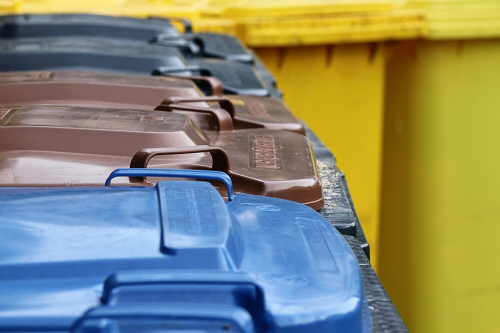Is China Building More Waste Incinerators Than It Needs?
中国过度投资垃圾焚烧产能了吗?
Several provinces may be investing too much in incineration, overlooking improvements in waste sorting and recycling
一些省份可能在垃圾焚烧方面投资过多,忽视了改善垃圾分类和回收
The vision to make China an “ecological civilisation” has been espoused at the highest political level. It includes, among other things, efficiently using resources, reducing waste and using extracted materials in a circular manner. Reaching these objectives will require timely and well-planned investments in waste-management capacity.
中国的“生态文明”理念得到了最高领导层的支持。生态文明的理念包括资源的有效利用、减少垃圾、以及循环利用等。要实现这些目标,就需要在对垃圾处理能力进行投资时及时、精心地加以规划。
China has invested largely in incineration over the past decade to help manage the massive growth in the amount of municipal solid waste, produced by homes and businesses. The latest government data, from 2018, shows that 99% of collected waste was managed, up from 67% in just 10 years.
过去10年,中国为应对生活和工业垃圾的大量增加,在垃圾焚烧方面投入巨大。2018年的最新政府数据显示,收集垃圾的处置率达到99%,而这一数字在10年前仅为67%。
However, in the coming years, more cities will follow Shanghai by making it compulsory to sort household waste. This is expected to reduce the demand for mixed-waste management.
然而,未来几年将有更多的城市效仿上海,对生活垃圾进行强制分类。预计这将减少对混合垃圾的处理需求。
Our research shows that these sorting schemes should be an important consideration for provinces as they plan new capacity to manage waste.
我们的研究表明,这些分类方案应该成为各省规划新垃圾处理能力时的一个重要考虑因素。
In our recent paper “Waste Available to the Chinese Energy Sector – Provincial Projections to 2050” my co-authors and I have combined econometric modelling with policy analysis to project how the make-up and quantity of collected waste could develop in Chinese provinces.
在我们最近的论文《中国能源部门可利用的废物——2050年各省预期》中,我和合著者将计量经济学模型与政策分析相结合,预测了中国各省垃圾收集的构成和数量的未来变化趋势。
Looking at mixed waste and sorted food waste, the paper presents several scenarios. The base scenario uses historical trends to predict future waste quantities in different provinces. Alternative scenarios take sorting of food waste and increased recycling into account.
针对混合垃圾和经过分类的餐厨垃圾,该文提出了几种方案。基本方案利用历史趋势预测不同省份未来的垃圾数量。替代方案将餐厨垃圾分类和增加回收考虑在内。
The forecasts focus on waste used to produce energy and only cover waste collected through official channels, not total generated waste. In China, the unofficial sector manages around a quarter of all waste generated, although this is likely to change as the official system collects and manages more recyclables.
预测重点关注的是用于生产能源的垃圾,而且只包括通过官方渠道收集的垃圾,并非所有产生的垃圾。在中国,非官方部门处理的垃圾占总量的约四分之一。不过,随着官方系统收集和处理的可回收物增加,这一情况可能会有所改变。

Our paper projects 39% of food waste to be sorted by 2030 and 57% by 2050
我们预计,到2030年和2050年厨余垃圾分类率将分别达到39%和57%
In the short term, the results show that several provinces, including Anhui, Tianjin and Zhejiang risk overinvestment in new incineration capacity because planned capacity for dealing with mixed waste exceeds the projected quantities.
研究结果显示,在短期内,包括安徽、天津和浙江在内的几个省市可能存在新建焚烧能力投资过剩的风险,因为混合垃圾的规划处理能力超过了预期产生数量。
These findings are true even without sorting of food waste or an increased focus on removing recyclable waste from the mixed waste stream. If the success of the waste-sorting scheme in Shanghai, which started last year, is replicable in other cities then several provinces could see reductions in mixed municipal solid waste as soon as this year.
即使在没有对餐厨垃圾进行分类,也没有加大力度将可回收垃圾从混合垃圾中分离出去的情况下,这些发现也站得住脚。如果去年在上海实施的垃圾分类方案能够成功推广到其他城市,那么几个省份的城市混合固体垃圾最早今年就会减少。
Of course, changing people’s behaviour to improve waste sorting can take a long time. Yet in Shanghai, great quantities of recyclables and organic waste have been separated in the city in a short time. Key to the success of the scheme has been extensive enforcement.
当然,通过改变人们的行为来改善垃圾分类可能需要很长时间。上海方案之所以成功,关键在于广泛推动落实该方案,从而在很短时间内就对大量的可回收物和有机垃圾进行了分类。
This level of enforcement may not be possible across China. However, based on assumptions that are conservative compared to the Shanghai case, our paper projects 39% of food waste to be sorted by 2030 and 57% by 2050, amounting to 61 million tons in 2030 and 109 million tons in 2050.
这样的力度不太可能在全国推广。然而,我们基于垃圾分类力度比上海保守的假设做出预计,到2030年和2050年厨余垃圾分类率将分别达到39%和57%,也就是6100万吨和1.09亿吨。
This waste should be managed properly, for example in anaerobic digesters, to produce biogas and fertiliser. The gas produced can be combusted or upgraded to natural gas quality for use in the energy system.
这些垃圾应该得到妥善的处理,例如在厌氧消化池中生成沼气和肥料。产生的气体可以燃烧或升级为可用于能源系统的合格天然气。
Sorting food can also improve the management of mixed waste. The energy content of Chinese municipal solid waste is typically too low to sustain combustion in incineration plants so fuel has to be added, often coal. Separation of food waste from mixed waste makes self-sustaining combustion possible and could reduce and even eliminate the use of co-firing with coal in about five years, our study finds.
餐厨垃圾分类还可以提高混合垃圾处理效率。中国城市固体垃圾的能量值通常太低,无法在焚烧厂燃烧,因此必须添加燃料,通常是煤。我们的研究发现,将餐厨垃圾从混合垃圾中分离有助于它们的自持燃烧,并且可以在大约5年内减少甚至不再需要添加煤炭助燃。
The extensive investments in municipal solid waste incineration well underway in China will significantly reduce the need for landfills. However, the path to an ecological civilisation is more ambitious than that; it includes waste reduction, sorting and increasing efficiency.
中国大举投资建设城市固体垃圾焚烧厂,将大大减少垃圾填埋的需求。然而,通往生态文明的道路远比这更为宽广,还有减少垃圾、垃圾分类和提高效率等其他选项。
Waste management planning should align with these aims to avoid overinvestments in, for example, incineration capacity. The trend of substantial investments in incineration could hinder the development towards an ecological civilisation if it continues, because utilising built capacity will be more profitable than changing practices and investing in sorting and recycling facilities.
垃圾处理规划应与这些目标相一致,避免在焚烧能力等方面过度投资。大量投资垃圾焚烧厂的趋势如果继续下去,可能会阻碍生态文明的发展,因为利用现有处理能力将比改变做法以及投资分类和回收设施更加经济。
英文、中文版本下载:http://www.yingyushijie.com/shop/source/detail/id/2396.html








